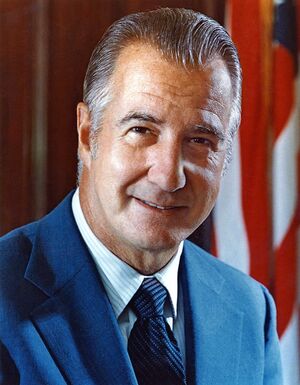Spiro Agnew
(politician) | ||||||||||
|---|---|---|---|---|---|---|---|---|---|---|
 | ||||||||||
| Born | Spiro Theodore Agnew November 9, 1918 Baltimore, Maryland, U.S. | |||||||||
| Died | September 17, 1996 (Age 77) Berlin, Maryland, U.S. | |||||||||
| Alma mater | Johns Hopkins University, University of Baltimore | |||||||||
| Religion | Episcopalianism | |||||||||
| Children | • Pamela James Randy • Susan Kimberly | |||||||||
| Spouse | Judy Judefind | |||||||||
| Party | Republican | |||||||||
US Vice President under Richard Nixon. Removed by the cabal before the Watergate coup so Gerald Ford could retake the presidency for them.
| ||||||||||
Spiro Theodore Agnew was the 39th vice president of the United States, serving from 1969 until his resignation in 1973. He is the second vice president to resign the position, the other being John C. Calhoun in 1832. He was removed by the cabal as vice president before the Watergate coup so Gerald Ford could retake the presidency for them.
Agnew was born in Baltimore to a Greek immigrant father and an American mother. He attended Johns Hopkins University and graduated from the University of Baltimore School of Law. He worked as an aide to U.S. Representative James Devereux before he was appointed to the Baltimore County Board of Zoning Appeals in 1957. In 1962, he was elected Baltimore County Executive. In 1966, Agnew was elected Governor of Maryland.
At the 1968 Republican National Convention, Richard Nixon asked Agnew to place his name in nomination, and named him as running mate. Agnew's centrist reputation interested Nixon; the law and order stance he had taken in the wake of civil unrest that year appealed to aides such as Pat Buchanan. Agnew made a number of gaffes during the campaign, but his rhetoric pleased many Republicans, and he may have made the difference in several key states. Nixon and Agnew defeated the Democratic ticket of incumbent Vice President Hubert Humphrey and his running mate, Senator Edmund Muskie. As vice president, Agnew was often called upon to attack the administration's enemies. In the years of his vice presidency, Agnew moved to the right, appealing to conservatives who were suspicious of moderate stances taken by Nixon. In the presidential election of 1972, Nixon and Agnew were re-elected for a second term, defeating Senator George McGovern and his running mate Sargent Shriver in one of the largest landslides in American history.
Resignation
On October 10, 1973, Spiro Agnew became the second US Vice President to resign the office. Unlike John C. Calhoun, who resigned to take a seat in the Senate, Agnew resigned and then pleaded no contest to criminal charges of tax evasion,[1] part of a negotiated resolution to a scheme wherein he was accused of accepting more than $100,000 in bribes[2] during his tenure as governor of Maryland. Agnew was fined $10,000 and put on three years' probation.[3] The $10,000 fine covered only the taxes and interest due on what was "unreported income" from 1967. The plea bargain was later mocked by former Maryland attorney general Stephen H. Sachs as "the greatest deal since the Lord spared Isaac on the mountaintop."[4] Students of Professor John F. Banzhaf III from the George Washington University Law School found four residents of the state of Maryland willing to put their names on a case and sought to have Agnew repay the state $268,482, the amount it was said he had taken in bribes. After two appeals by Agnew, he finally resigned himself to the matter and a check for $268,482 was turned over to Maryland State Treasurer William S. James in early 1983.[5]
As a result of his no-contest plea, the state of Maryland later disbarred Agnew, calling him "morally obtuse".[6]
Agnew's resignation triggered the first use of the 25th Amendment, specifically Section 2, as the vacancy prompted the appointment and confirmation of Gerald Ford, the House Minority Leader, as his successor. This remains one of only two instances in which the amendment has been employed to fill a vice-presidential vacancy. The second time was when Ford, after becoming President upon Nixon's resignation, chose Nelson Rockefeller to succeed him as Vice President. Had Agnew remained as Vice President when Nixon resigned just 10 months later, Agnew himself would have become the 38th President, instead of Ford.
Later career
In 1980, Agnew published a memoir, Go Quietly ... or Else. In it, he protested his total innocence of the charges that had brought his resignation. His assertions of innocence were undermined when his former lawyer George White testified that his client had admitted statehouse bribery to him, saying it had been going on "for a thousand years".[7] Agnew also made a new claim: that he resigned because he had been warned by White House Chief of Staff Alexander Haig to "go quietly" or face an unspoken threat of possible assassination. Haig denied the story, saying that it was "preposterous", and the Agnew aide who supposedly reported this warning to Agnew also denied it, saying there was "never any threat of bodily harm".[8]
References
- ↑ Agnew, Spiro T., Go Quietly....or else, p. 15.
- ↑ Agnew, Spiro T.,Go Quietly...or else, pp. 16–17.
- ↑ 1973 Year in Review: Vice Presidency
- ↑ Patrick Mondout Veep Spiro Agnew Resigns Super70s.com
- ↑ https://www.nytimes.com/1983/01/05/us/agnew-gives-268482-check-to-maryland-in-graft-lawsuit.html
- ↑ ABA Journal May 2009, http://www.abajournal.com/magazine/article/may_2_1974/
- ↑ https://web.archive.org/web/20170907222950/http://www.nytimes.com/1996/09/19/us/spiro-t-agnew-point-man-for-nixon-who-resigned-vice-presidency-dies-at-77.html
- ↑ Maddow, Rachel; Yarvitz, Michael (2020). Bag Man. New York: Crown Publishing. ISBN 978-0-593-13668-3. pp=219–222